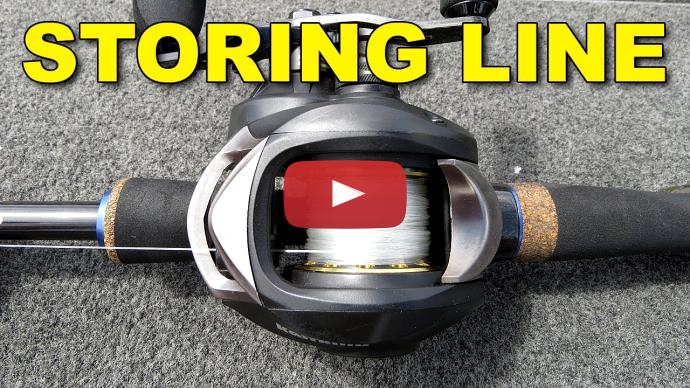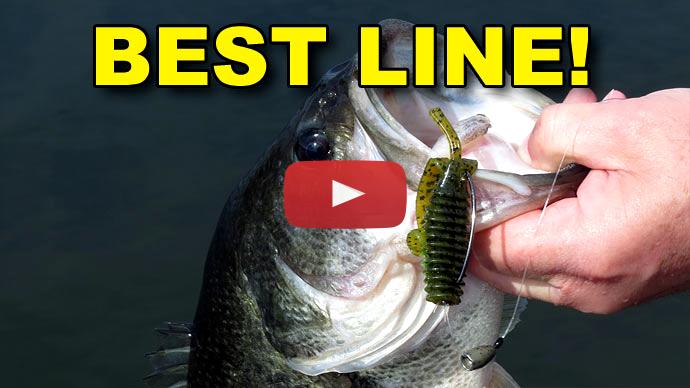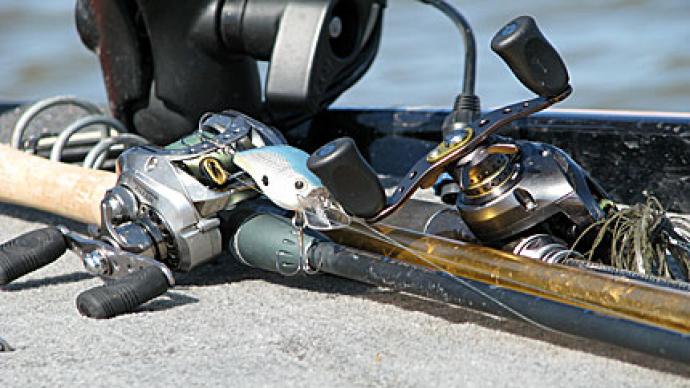I've been using fluorocarbon since it got popular, before it got popular. I was one of probably the first guys who used it in the US. I forget how long ago it was, over ten years ago. I tied Palomars back then, and they used to pop it off a lot. I had some Japanese friends on tour and stuff, in Kota, and some of the guys that fish, they know a lot of technical stuff, and probably from Japan.
And to make a long story short, I get a lot of Japanese catalogs and magazines, and there's a lot guys back east that still use the Palomar. VanDam's one of them. He's one of the biggest guys that still use the Palomar on fluorocarbon. Four or five times I've taken his baits and snapped them off just to show him, throughout the year, since I know him well. I would take his crankbait and just pop it. And then I'll tie my knot on. And it's heavy line, you feel it, it's like 16 or something, and I'll just pop it off. And I'll tie mine on and actually kind of do the same thing and it doesn't break, and I'll do it four or five times, and then I'll give it to him. And he still does it, he still does the Palomar.
I've never seen a Palomar knot in a Japanese brochure or magazine ever. They don't even talk about it. They have all these knots. They'll have a whole page of knots, like, eight, ten different knots, how to do them. Even two pages, I've never seen them illustrate a Palomar. That's how against it they are. But, you're losing 10 percent to 20 percent of knot strength, and I can show you guys.
I'll be here as long as you guy want, I don't have to fly out till tomorrow. But, I'll show you some knots I got. The one thing I can tell you, there's a lot of good knots, and slips. They don't really . . . they're actually specified as slips, like nooses, like a hangman's noose is basically what it is. On fluorocarbon, anything that kind of cinches down and doesn't bind is a good way to connect your bait to fluorocarbon.
There's not really that many knots. There's only a Palomar. The rest of them are actually slips. There's a Trilene, there's a San Diego, Improved Clinch. They're all kind of similar. There's some easy ones I can show you that I used to tie that are really good. They're way better than a Palomar, but they're less consistent and I'm all about consistency. And I don't want to risk having an overlap somewhere and snap off a big fish. Because I do pull so hard, I need a perfect knot.
So the one I use is a Uni. I double the line, make a big loop, and then I tie it, which I can show you later. One of the things I can tell you is on those slips is you've got to do a lot of wraps. So, a minimum, to me, I think is about six. Six wraps. And if you use two pounds, or three pounds for trout, which I do sometimes, I use eight wraps. Because it's literally almost a hundred percent, up in the high 90's, 98%, 99% knot strength.
The same thing with braid. Braided line, I use anywhere from ten to fourteen wraps. The lighter I go, the more wraps I do. The fluorocarbon, now, you'll notice, I always fish on the heavier lines. They'll be a little big, but it's never affected the way they hit it, and it's so strong that that's all I use. I do connect the fluorocarbon to the braid with the same knot. I just do two of them, so. I can show you some of that stuff later.
Hi, I'm Aaron Martins here with Limit Out Marine in Washington. I'm going to show my knot that I use. It's an old saltwater knot. It's called a uni. You can call them Razo knot. Razo takes a little bit of credit for it, but I think a lot of salt water guys always double their knots. Basically it's a uni knot doubled, with the line doubled. It makes you able to do it on the drop shot rig. If you do it singly, you've got a long tie again, but if you double it, you have a short loop.
Right here I have some high-colored high-vis braided line and a really big hook so you can see good. Probably right in this area is good for you. Pretend this is my main line here. It's main longer. Take it and double it up. What I do is when I take that loop and double up with fluorocarbon or braid, too. That works good with everything.
I usually give it a little pinch. Obviously this is big stuff and this is a big hook, but with the smaller lines I just give a pinch so it's easier to get in the eye of the hook. Once I do that, you're going to slide it like so. Give yourself enough line. That's the most important thing you want to do is don't give yourself like that much because you'll make it really hard on yourself. Give yourself, especially starting out with this knot, give yourself a lot of material to work with.
Here is your main line. The tag end's right here. All right, grab it like so. Usually by now I'll grab my main line, my tag in, which is a loop that came through. I made that loop. I'm going to grab this loop and slide the hook up, holding this piece the tag in the main line. With my same hand...That's the hardest part about this knot you're going to find is hand position. I take my right hand and my pinkie and whatever finger this is called, and then hold it there. Hold it tight.
I'm not really holding the hook. The hook I'm just holding wherever the eye is at. Then you take these two fingers on your right hand. This is how I do it. You might have a better way. When I take it I kind of turn it downwards. This just makes it easier to do your loops. What I'm going to do now is I'm holding it with both hands. You're going to have to watch this video over and over again.
What I'm going to do is I'm going to wrap up...My loop's a little long but, if you're following, and anywhere between six and seven or eight wraps on fluorocarbon. This is only like five wraps but...Braided lines, lighter stuff I use 12 wraps and the heavy stuff I use 10-11, or even 12 wraps. It's really good with braid. It's really good with fluorocarbon. This is the strongest knot I've found so far.
If there's a better one out there, please let me know, but this is the strongest knot I've found. It really is close to 100 percent knot strength. You saw how I just cinched that tight, kind of pulled on the hook a little bit, pulled on the main line and the loop a little bit at the same time. Once you cinch it down like so, you want to make sure...See that little piece how it kind of made a loop? You want to make sure you pull those at the same time.
You can fix this knot. If you mess it up, you can usually fix it. Now I'm pulling the tag end and the main line, and you just slide it down. It's actually not really called a knot. This is called a cinch. Once you get to that point you cinch it down really tight and it makes a really nice tight knot. When you're done, you're going to cut that loop and the tag end off, and that leaves you with a nice tight uni. That's it. Just practice makes perfect.
Takes a long time to be efficient at it, but once you are it's actually as fast as a Palomar. I've tied it with one of the anglers back East. Kevin Wiggins? Well I forgot his name, but he's really good with a Palomar, and we tied our knots together. Mine was the same time as his, and he ties a Palomar all the time. Once you get efficient at it, it isn't that much more time to tie it, and it's a lot stronger. Try it out.





